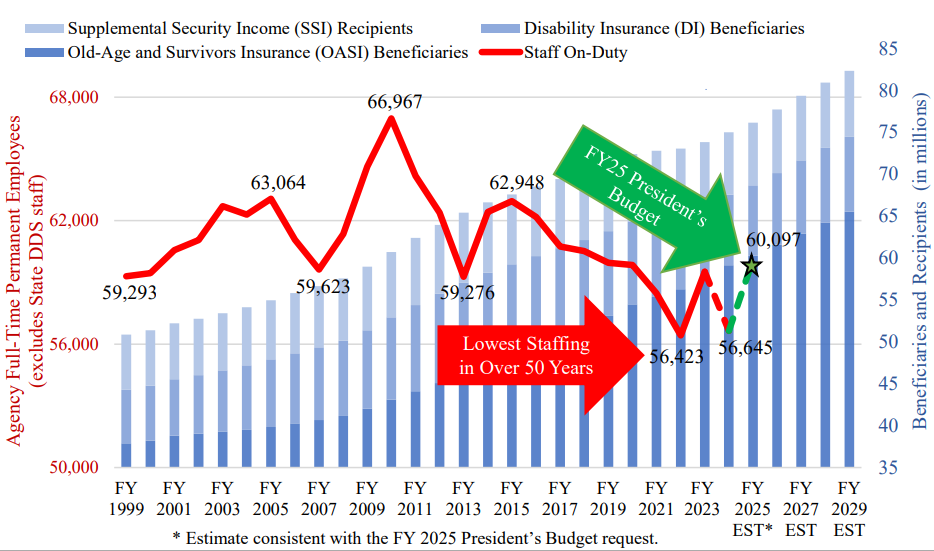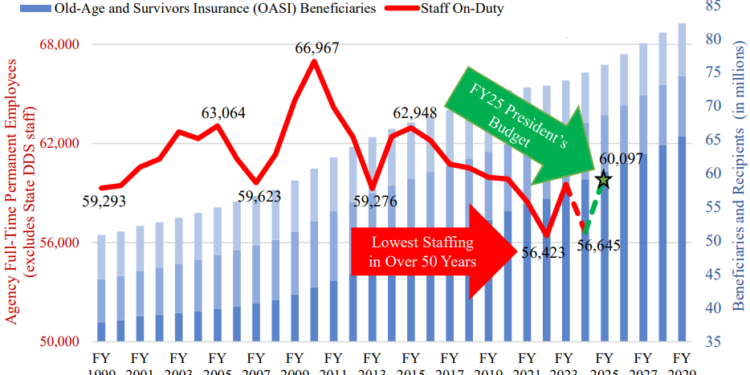As Congress approaches another deadline to reach an agreement on fiscal 2025 government spending levels, Social Security Administration leadership is warning that without enough resources, the agency will hit yet another record-low staffing level and lose thousands of employees in the coming months.
During a House Appropriations Committee hearing Wednesday, SSA Commissioner Martin O’Malley called the full Biden administration budget request of $15.4 billion for 2025 a “big step in the right direction.”
“The modernization budget has dwindled to nothing. When you’re operating on legacy systems without any IT modernization, more and more of that budget every year is taken up with keeping it taped together,” O’Malley told lawmakers on the appropriations committee’s subcommittee on Labor, Health and Human Services, and Education. “In fact, any amount less than the president’s budget would have severe consequences for every American. We cannot stand back and watch this agency crater.”
Currently, SSA is operating with a budget of $14.2 billion under the continuing resolution. But in a few weeks, agencies may be facing another threat of a government shutdown. In September, Congress passed a continuing resolution to fund agencies at their 2024 spending levels. Lawmakers have to agree on and pass either full-year appropriations or another continuing resolution by Dec. 20 to avoid a government shutdown.
Wednesday’s appropriations hearing for SSA also comes just a few days after O’Malley announced his resignation, which will take effect Nov. 29.
For 2025, the GOP-led House Appropriations Committee’s budget proposal of $13.8 billion is $401 million below the agency’s current spending levels.
“The Social Security Administration has received an increase of its appropriations nearly every year over the past decade. The administrative funding to run the agency has increased by nearly $2 billion,” Subcommittee Chairman Robert Aderholt (R-Ala.) said during Wednesday’s hearing. “While I do recognize the agency has not received the amount requested in the president’s budget for some of those years, such an increase does represent an amount far greater than other agencies and programs in this bill.”
In his prepared testimony, O’Malley argued that the House’s spending proposal would be “catastrophic” for SSA’s operations. He said the slashed budget would lead to SSA temporarily shutting down phone and field office services, ceasing the processing of hearings, as well as cutting overtime and putting the agency into a hiring freeze.
O’Malley pointed to what he said is a 50-year staffing low at SSA, as the number of Social Security beneficiaries continues to rise. He said the disparity between resources and beneficiaries is a key reason behind SSA’s lagging customer service.

Subcommittee Ranking Member Rosa DeLauro (D-Conn.) called the backlogs and low staffing a “crisis” at SSA, pointing to budget and resource limitations as the reason behind the challenges.
“If you defund an agency to the point of dysfunction, then it becomes easier to mislead the public into believing that that agency is not working,” DeLauro said.
SSA, though, managed to make improvements to its services earlier this year. Wait times on the national 1-800 number are trending downward, and the time it takes to receive an initial disability determination is declining. The backlog for administrative law judges is also decreasing.
But O’Malley said SSA started the new fiscal year under a hiring freeze, threatening to wind back the progress the agency is beginning to make. Without sufficient resources through 2025, O’Malley said the agency won’t be able to continue making those improvements. He is also pushing for a budget anomaly for SSA to be able to tackle larger, long-term goals for the agency, such as IT modernization.
“One of my deep concerns about this agency, when I depart next Friday, is a looming problem on the horizon of antiquated IT systems totally breaking down or being shut down by bad actors,” O’Malley said.
The White House budget request aims to bring SSA up to nearly 60,000 employees — on par with the end-of-year staffing levels from 2023. The budget request aims to invest in more SSA staffing across the board, with $269 million for field offices, $85 million for processing centers, $89 million for hearing centers, $79 million for teleservice centers and $2.8 billion for Disability Determination Services.
“The president’s budget would allow us to greatly restore staffing at the field offices, the state DDS offices, the 1-800 number, and would allow us to, finally, to make some meaningful headway in modernizing our very old technology,” O’Malley said.
Republican committee members, however, questioned SSA’s continued challenges with customer service and delivery despite budget increases in most fiscal years.
“If your costs are going up $600 million every year, perhaps y’all should get together with the new agency, the Department of Government Efficiency, and maybe Elon Musk and Vivek can help you guys trim that,” Rep. Andrew Clyde (R-Ga.) said during the hearing.
Telework at SSA raising committee eyebrows
Telework and return-to-office policies were another point of contention for lawmakers on the appropriations subcommittee. Currently, most SSA headquarters employees in Baltimore and Washington, D.C., as well as regional office employees, are working onsite two to three days per week. About 1.3% of the agency’s workforce is fully remote, according to O’Malley’s testimony.
But Aderholt said many members of the subcommittee remain concerned about the current telework levels for SSA employees. He blamed telework for SSA employees as a key reason behind the customer service challenges the agency has been experiencing.
“Prior audit reports have highlighted concerns with Social Security Administration’s ability to measure productivity in telework and noted that the agency did not restrict telework by job position,” Aderholt said. “I think it’s unacceptable that an agency with more than 50,000 employees would not have some policy of determining whether an employee’s job is inherent frontline customer service.”
“There have to be people manning the field offices,” Clyde added. “If three days out of the week is the requirement, then why is it not five days out of the week?”
But comparing governmentwide, O’Malley said SSA is sitting at about the “middle of the pack” when it comes to levels of onsite work versus telework. He pointed to a 6.2% increase in productivity over the last year for the agency’s hybrid workforce. Additionally, O’Malley said the agency has ways of monitoring employees who are teleworking to ensure they remain productive, regardless of where they are sitting.
“I believe that we’ve achieved the right balance between telework and onsite work,” he said.
At the same time, O’Malley said the current SSA workforce is struggling largely because of the rising workloads. He pointed to the results of the Partnership for Public Service’s Best Places to Work in the Federal Government series as a sign of the changing feedback from agency staff over time.
“Our agency listed itself the worst place to work in the federal government, and that’s a stunning decline from 12 years ago, when they rated themselves one of the best places to work,” O’Malley said. “But that’s a reflection of the fact that their workloads been going up … and the number of colleagues around them going down … A lot of people in these field offices ask themselves every day, am I going to be the last one here to turn off the lights?”
Currently, SSA has a staff attrition rate of 7.6%, which is 1.7% above the governmentwide attrition rate of 5.9%, according to data compiled by the Partnership for Public Service. About 20% of SSA employees said they plan to leave the agency in the next year to take another job in the federal government.
At SSA field offices, there are “a lot more windows than there are staff,” O’Malley said. “And it’s not because we’re lazy. It’s not because we don’t show up for work. It’s because there are fewer of us.”
Copyright
© 2024 Federal News Network. All rights reserved. This website is not intended for users located within the European Economic Area.





